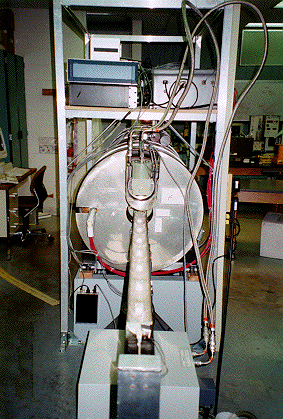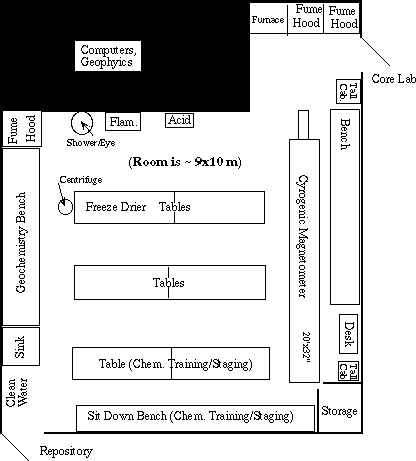Supervising Scientist: Gary Acton
Related Information:

The long-core cryogenic magnetometer with the discrete sample tray loaded.
ODP/TAMU Shorebased Paleomagnetism Lab
Paleomagnetists: Gary Acton and Carl Richter1. BACKGROUND: The long-core cryogenic magnetometer formerly on board the JOIDES Resolution (the drill ship for the Ocean Drilling Program), was replaced by a new magnetometer in June 1996. The old magnetometer was moved to the ODP building on the Texas A&M University campus so that it could be setup in a laboratory near the ODP Gulf Coast Repository, which stores over 70 km of core. This 2G Enterprises Model 760-R cryogenic magnetometer is in excellent working condition, and will thus continue to be a valuable resource for research and teaching. As of 18 August 1997, the magnetometer setup was completed.
2. PURPOSE: Our primary goal is to operate the long-core cryogenic magnetometer within a laboratory that has access to a large core repository and that has associated equipment for investigating rock magnetic properties. The long-core magnetometer is automated and has in-line alternating field (AF) demagnetization capabilities. The new facility will be used in a variety of research projects, in classes at both the undergraduate and the graduate level at Texas A&M University (TAMU), for graduate research projects, and will be made available to visiting scientists for routine measurements on ODP cores that were not completed at sea due to time or equipment limitations.
3. PROGRESS REPORT: The magnetometer was fully functional as
of 18 August 1997. The magnetometer is capable of measuring core sections
(full or split) up to 1.5 m long and with diameters
less than about 7 cm as well as discrete samples.
4. ENDORSEMENT: Operation of the long-core magnetometer at ODP/TAMU has been endorsed by the Shipboard Measurement Panel, an independent group of scientists that advises ODP on matters concerning scientific measurements on deep sea cores, and by the paleomagnetism community:
"We advocate that the existing shipboard magnetometer be placed at College Station preferably in a magnetically shielded room. In this optimal environment, the instrument's performance would be greatly enhanced compared to its shipboard performance. At College Station, it could be used for analysis of archived cores, and for detailed post-cruise studies."
6. RESEARCH OBJECTIVES: The primary function of the lab will be to conduct research. Besides being open to researchers and students at TAMU, the laboratory will be available for use by scientists around world to conduct a wide array of studies. We hope the facility will attract visiting scientist and expose us and students at TAMU to new and innovative science, and promote the exchange of information and ideas amongst magnetists. Some of the research projects planned for the new facility will examine:
7. EXISTING LABORATORY EQUIPMENT: The CTF cryogenic magnetometer (which measures discrete samples, typically 5-15 cc) that resides in the Geology & Geophysics (G&G) building is not functioning and will unlikely be repaired. We are in the process of moving other equipment from the G&G building to the ODP building, to create one functional laboratory. The overall paleomagnetism facilities at TAMU include:
Cryogenic Magnetometer
9. ACKNOWLEDGMENTS:
The lab could not have been setup without the hard work and expertise of several individuals.
In particular, Margaret Hastedt played the most critical role in helping disassemble
the magnetometer at the end of Leg 167 in San Francisco, unpack it and reassemble it in
College Station, build a new wooden frame for it to sit upon, and help with refilling and
tuning the magnetometer. Bob Olivas and Brad Julson assisted with efforts to get the
magnetometer back to College Station in full functioning order.
Randy Current, Sandy Dillard, Bob Kralich, and several student workers assisted
Margaret with the design and construction of the large wooden frame in September 1996
and subsequent reconfigurations.
Will Sager and Texas A&M University provided additional lab equipment.
Bill Mills provided the software and has assisted with track design.
Eric Meissner, Trevor Cobine, Larry Obey, Charlie Endris, and Matt O'Regan assisted
with tuning and refills. Bill Goree gave us valuable information over the phone when
minor problems arose.
10. LABORATORY PHOTO GALLERY
JUNE 1998 UPDATE:
A proposal was submitted to NSF in mid-December 1996 that requested funds (about $20,000)
for the minor upgrades and new AF demagnetization coils, which were intened to extend the in-line
demagnetizer's peak AF field capabilities to 80 mT.
The proposal was not funded, so the in-line AF unit is limited to 25 mT.
Discrete samples can be further thermally or AF demagnetized in the Schonstedt TSD-1
magnetically-shielded oven and Schonstedt GSD-1 AF demagnetizer.
DECEMBER 1998 UPDATE: The water chiller broke resulting in a shutdown of the coldhead
and loss of helium. Because a new water chiller was needed and funds were not available,
the magnetometer was not refilled with helium.
JUNE 2000 UPDATE: A Bartington 80-mm diameter susceptibility loop was inserted into the
track and the software was updated to allow automated measurements of susceptibility.
Thus, even though the magnetometer is not functioning, the track is being used
for making susceptibility measurments on split-cores and U-channel samples.
Comments from the JOI/USSAC Workshop on Geomagnetic Polarity Records from ODP Cores represented by 28 of the leading paleomagnetists from around the world (Nov 1994).
In addition, TAMU and ODP combined have one of the largest core collections in the world. Many of the TAMU cores have not been studied paleomagnetically and other cores at ODP have not been demagnetized in fields sufficient to remove overprints. The alternating field (AF) demagnetization capacity of the long-core magnetometer on the JOIDES Resolution was 9 mT prior to Leg 123 and had not exceeded 30 mT until the addition of the new magnetometer on Leg 168 (June 1996). These fields are often too low to remove magnetization components imparted to the core by the drill string. Time limitations on many cruises have prevented even initial natural remanent magnetization measurements on duplicate cores (e.g., those collected at sites with multiple cored intervals). Moreover, it was impossible to measure cores with low magnetic intensities in the shipboard environment. Thus, the magnetization of many of the cores has not been properly assessed. Valuable magnetostratigraphic records, paleoclimate proxies, paleomagnetic poles, geomagnetic information, and more are awaiting discovery. Having the long-core cryogenic magnetometer available at the core repository now makes these types of studies feasible and cost effective.
a) Variations in rock magnetic properties as proxies for climatic variations
b) Nondipole field behavior over the past 5 m.y.
c) Paleointensity variations within a chron and over longer time intervals
d) Paleomagnetic poles and plate motions
e) Magnetostratigraphy and secular variation of the geomagnetic field
(a) 2G Enterprises 760R long-core cryogenic magnetometer with an in-line AF demagnetization unit (see full description below);
(b) Schonstedt DM2220 digital fluxgate magnetometer;
(c) Schonstedt GSD-1 AF demagnetization unit;
(d) Schonstedt TSD-1 magnetically-shielded oven;
(e) ASC IM-10 Pulse magnetizer;
(f) CTF cryogenic magnetometer (NON-FUNCTIONAL);
(g) Magnetically shielded room (currently in the Geology & Geophysics building, but may be moved to ODP building); and
(h) Bartington susceptibility loop/meter
The 2G 760-R superconducting rock (cryogenic) magnetometer is used primarily for continuous
remanence measurements on archive halves of cores. AF coils arranged on-axis with the magnetometer and
set within the magnetometer's mu-metal shielding allow uniform demagnetization of the cores, so that
both NRM and demagnetized remanences can be measured. Whole cores can be run providing that their
diameters are first checked to assure that no bulges are present; otherwise, cores may become stuck.
The cryogenic magnetometer may also be used to measure and demagnetize discrete samples.
Measurements on the cryogenic magnetometer are initially made in units of magnetic flux, phi0;
calibration to magnetic moment (mA·m2) depends on the geometry of the coils, and so varies from axis to axis.
Prior to Leg 121, calibration factors were
x-axis, 1 phi0 = 1.740 x 10E-4 mA·m2;
y-axis, 1 phi0 = 1.646 x 10E-4 mA·m2;
z-axis, 1 phi0 = 1.215 x 10E-4 mA·m2.
Since Leg 121, the calibrations have been
x-axis, 1 phi0 = 1.77 x 10E-4 mA·m2;
y-axis, 1 phi0 = 1.57 x 10E-4 mA·m2;
z-axis, 1 phi0 = 1.32 x 10E-4 mA·m2.
After processing, measurements are reported in units of mA/m. Raw x, y, and z files are not routinely saved.
The theoretical noise level of the superconducting quantum interference device (SQUID) sensors is 3 x 10-5 phi0.
The noise level observed on the JOIDES Resolution depended, in part, on the amount of roll of the ship.
Measurements of the empty sample boat indicate a magnetic moment (within the measuring region, which is
equivalent to a volume of about 150 cm3 when a full archive half is being measured) on the order
of 10E-6 mA·m2 (10E-6 emu). On shore, the magnetometer should be about 5 times more sensitive
based on results from similar instruments. The strongest samples that have been measured with
the cryogenic magnetometer are half cores of basalt with intensities up to 8000 mA/m.
The results produced by the shipboard cryogenic magnetometer have been compared with those produced by the shipboard spinner magnetometer and with those obtained using shorebased equipment. Good correlation has been demonstrated, as illustrated below.
The cryogenic magnetometer lies inside three concentric mu-metal cylinders (see photograph). Its AF coil assembly is also contained within these shields. Prior to Leg 123, a system was installed that increased degaussing potential from 9 to 25 mT. Prior to Leg 132, the axis control boxes were upgraded to improve flux-jump counting capabilities. A superconducting lead shield surrounds the sensing region and maintains an absolutely stable field within that region.
8. LABORATORY LAYOUT: The laboratory is located on the far south end of the ODP building next to the refrigerated core storage area and the core lab, both of which comprise the Gulf Coast Repository. It is roughly a 10 x 9 m room, which will be shared with the geochemists and a small workstation area.  Laboratory layout
Laboratory layout
Several photos taken during installation of the magnetometer.
